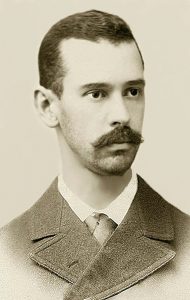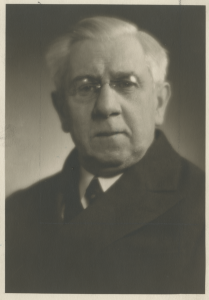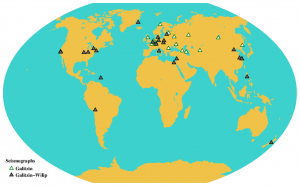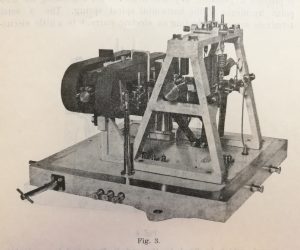The famous Danish seismologist Inge Lehmann (1888–1993) published in 1936 a succinctly named article (P’) dealing with her revolutionary discovery: the core of the Earth consists of an inner and an outer layer. The article presents a recording of the 16 June 1929 magnitude-7.3 New Zealand earthquake at the Scoresby Sound seismic station in Greenland (Figure 1). Few people know that the equipment of the station had been built in Estonia in a fine mechanical workshop located in Tartu and the high quality of Estonian equipment made it possible to accomplish this kind of observations. Estonian seismographs were a hit product of their time that ended up in five continents.
Global seismology started to form at the end of the 19th century. At the forefront of this field were Italy, Japan, Great Britain, and Russia together with Estonia. The initial seismological circles were small and observational instruments were developed by a handful of inventors.
The key figure of the dawn of Russian instrumental seismology was the nobleman from St. Petersburg, a prince and a physicist Boris Golitsyn(Galitzin, 1862–1916, figure 2). His innovative Galitzin seismographs upgraded earthquake measurements to a new level. Most of the current seismometers still operate with the principle he figured out.
Friction between different moving parts of initial mechanical seismographs was a nuisance. Galitzin made several inventions for improving the seismographs. The most important one he did in 1902 when combining the registering apparatus of the seismometer with a galvanometer. The mechanical system was thus converted in an electric current. This lowered the level of background noise in the seismographs drawn on photographic paper and signals could be analysed more accurately.
Galitzin spent one semester as a professor of physics at the Tartu University in the autumn 1883. He returned to St. Petersburg to be the professor of Maritime Academy in 1894–1914 and he was the head of the main geophysical observatory from 1913 on.
The Estonian peasant boy Johan Vilip (Johan Vilip, 1870–1942, Figure 3) started studies of physics at the Tartu University in 1891. He passed the course of meteorology by Galitzin with good grades. After graduating Wilip could not find work in Tartu and Galitzin hired him in 1896 as a trainee and helper of the assistant of the St. Petersburg laboratory. Wilip became later an assistant himself and finally the head of the laboratory.
Galitzin invited in 1901 from Germany to St. Petersburg the fine mechanic Emil Hugo Gottfried Masing(1875–1939, Figure 4) who was originally from Tartu. His task was to establish a workshop of seismographs and other scientific instruments. Co-operation between the trio was launched when Masing started to compile equipment sketched by Galitzin. Wilip specialized in testing them. The new seismographs gained fame and in 1906–1916 they were ordered in 16 observatories in the Russian Empire and Europe (Figure 5).
Unfortunately, the fruitful co-operation ended abruptly in 1916 because of the untimely death of Galitzin. Masing and Wilip kept on with their work in St. Petersburg after the Russian Revolution. However, due to unfavourable circumstances they relocated to Estonia in 1920.
Masing founded in Tartu in 1921 a precision mechanics workshop Scientific Apparatus Industry Hugo Masingwhere scales and scientific equipment were manufactured principally for the Tartu University. The seismographs turned out to be the most valued items. Johann Wilip for his part became a professor of physics and the head of the Department of Physics at the Tartu University.
Three orthogonal pendulum systems are needed for resolving ground movement caused by seismic waves. Modern seismometers typically contain all three under one casing. Earlier three separate seismometers were placed to a seismic station, a vertical one and two identical horizontal ones in north-south and east-west directions.
Although Galitzin-seismographs were an essential improvement, there were also major deficiencies. The vertical seismograph was very sensitive in regard with temperature. A change of even only a fraction of a degree made the recording pen to drift unevenly. Spaces between subsequent seismogram lines could vary or the lines even crossed each other, hampering observations of true ground movement.
In the Tartu workshop the duo improved first the horizontal seismograph. The period of its pendulum was uneven because of magnetism of the damping system. This phenomenon was eliminated. However, the most important issue was the invention of temperature compensation for the vertical seismograph. Moreover, the hanging system of the pendulum was made steadier. Disturbances due to air flow were hindered by placing a protective glass box on top of the sensor.
The new generation Galitzin-Wilip-seismographs aw the daylight in 1925 (Figures 6 and 7). In that time the Danes wanted to acquire best available apparatuses for the seismic stations in Copenhagen and Greenland. After testing of products by various manufacturers the Galitzin-Wilip equipment were chosen. Orders from around the world started streaming in Tartu after this breakthrough.
Altogether 23 Galitzin-Wilip seismograph sets (one vertical and two horizontal components) built in Tartu ended up in observatories in five continents during 1926–1939 (Figure 5). The list is awe-inspiring – Europe: Copenhagen, Scoresby Sound, Potsdam, Stuttgart, Warsaw, Krakow, Tartu, Rome; Asia: Beirut, Manila, Peking, Nanjing, Shanghai; America: New York, Cincinnati, St. Louis, Berkeley, Santa Clara, Buffalo, La Paz (Bolivia), Martinique (Lesser Antilles), Oceania: Wellington; Africa: Cairo.
Dark clouds gathered above the flourishing production of seismographs and tumultuous events in the world cut it once again. The Tartu seismic station established in 1931 had to stop its observations in 1939 because no photographic seismograph paper was available. Masing was ill and died around this time in Poland when fleeing towards Germany. A bomb dropped by Russians hit the workshop of Masing in 1943. As a consolation, Wilip had passed away a year before, saving him from witnessing that sight.
The production of the Galitzin-Wilip seismographs was continued in Germany during the 1950s by the company Askania-Werke AG led by Woldemar Masing, the son of Masing. They were in use at 50 seismic stations during the 1960s and in 1970 still at seven stations before the development of technology placed them in the history of seismology.
Heidi Soosalu, seismologist at the Geological Survey of Estonia and senior lecturer at the Department of Geology, Tallinn University of Technology

Figure 1. Figure 1. The P’ wave records of the New Zealand Buller earthquake at the Scoresby Sound seismic station (Lehmann 1936, Figure 6). Components: E – horizontal east-west, N – horizontal north-south, Z – vertical.

Figure 2. Boris Golitsyn (Wikimedia Commons).

Figure 3. Johan Vilip (Normann 1920).

Figure 4. Hugo Masing (Riedel).

Figure 5. Galitzin- and Galitzin-Wilip seismographs at the seismic stations in the world.

Figure 6. A Galitzin-Wilip vertical seismograph. The dimensions of the bottom of the instrument are 43,3 cm x 45,3 cm (Wilip 1930, Figure 3).

Figure 7. A cross-section of the Galitzin-Wilip horizontal seismograph (Wilip 1926, Figure 1).
The blog text is shortened from an article in Estonian, including the references:
Soosalu, Heidi (2024). Eesti seismoloogia hiilgav minevik (The glorious past of Estonian seismology). Eesti Geoloogia Seltsi Bülletään 10/24. Kliimast, geoloogiast, ringmajandusest ja ajaloost, p. 57–93. Link to the article.
